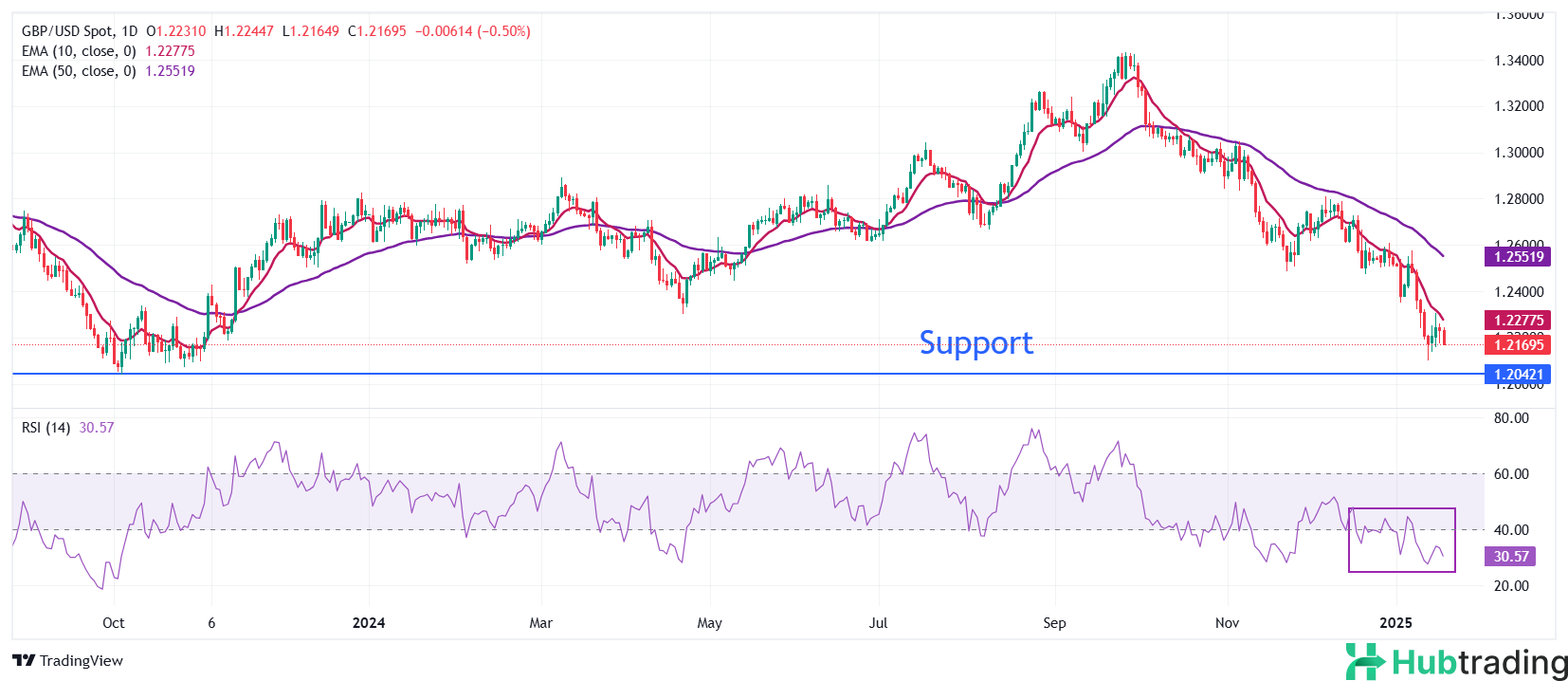- The Pound Sterling lags behind its major peers as disappointing UK Retail Sales data strengthens expectations for a Bank of England (BoE) interest rate cut in February.
- UK monthly Retail Sales fell by 0.3% in December, contrary to expectations for a 0.4% growth.
- The US Dollar strengthens, despite a slight uptick in dovish bets on the Federal Reserve.
The Pound Sterling (GBP) drops sharply against its major peers on Friday following the release of disappointing UK Retail Sales data for December, which showed a surprise contraction. The Office for National Statistics (ONS) reported that Retail Sales declined by 0.3% month-on-month, contrary to expectations for a 0.4% growth, adding to the weak economic outlook. Food store sales volumes, in particular, fell 1.9%, the lowest since April 2013, with the largest declines seen in supermarkets and specialist food stores, including butchers, bakers, and alcohol and tobacco outlets.
This slump in consumer spending raises expectations that the Bank of England (BoE) may cut interest rates by 25 basis points to 4.5% at its February meeting, as the UK faces cooling inflation and increasing government borrowing costs. The December Consumer Price Index (CPI) showed a slowdown in headline inflation, further supporting the case for policy easing.
Meanwhile, rising UK gilt yields, which surged to 5.48% for 30-year bonds, remain a key concern. Investors are wary about the economic outlook, fearing persistent inflation and a potential trade war with the United States under President-elect Donald Trump, who is expected to raise import tariffs and negatively impact the UK’s export sector.
Looking ahead, the next major event for the Pound will be the release of labor market data for the three months ending in November on Tuesday. Investors will closely analyze the employment figures to assess the impact of increased employer contributions to National Insurance (NI), announced in Chancellor Rachel Reeves’s first Autumn budget.
Daily Digest Market Movers: Pound Sterling Weakens Against USD as Trump's Inauguration Approaches
-
The Pound Sterling drops to near 1.2160 against the US Dollar (USD) in Friday's session, pressured by weak UK Retail Sales data and a stronger US Dollar. The US Dollar Index (DXY), which tracks the Greenback's value against six major currencies, rises sharply above 109.20. Despite investors digesting a slight increase in dovish bets on the Federal Reserve, fueled by slower-than-expected growth in the core Consumer Price Index (CPI) for December, the USD remains broadly firm.
-
According to the CME FedWatch tool, traders are now pricing in more than one 25-basis-point interest rate cut this year, with the first expected in June. Fed Governor Christopher Waller, in an interview with CNBC, noted that if soft inflation data persists, rate cuts could occur in the first half of the year, with March also remaining a possibility if inflation progresses and the labor market stays solid.
-
Looking ahead, investor attention turns to President-elect Donald Trump’s economic policy announcements after his swearing-in ceremony on Monday. Market participants anticipate Trump will unveil new import tariff plans and tax cuts for individuals shortly after taking office. Trump's Treasury pick, Scott Bessent, emphasized the urgency of lowering individual taxes to avoid a potential economic crisis.
Technical Analysis: Pound Sterling Faces Downward Pressure After Rejection at 10-Day EMA

The Pound Sterling resumes its downward trend against the US Dollar following a brief rebound to the 10-day Exponential Moving Average (EMA) near 1.2313 earlier this week. Currently trading around 1.2278, the GBP/USD pair maintains a bearish outlook, as the 50-day EMA continues its downward slope around 1.2552.
The 14-day Relative Strength Index (RSI) remains within the 20.00-40.00 range, signaling strong bearish momentum.
On the downside, support is likely near the October 2023 low of 1.2050, while resistance is seen at Wednesday’s high of 1.2306.





